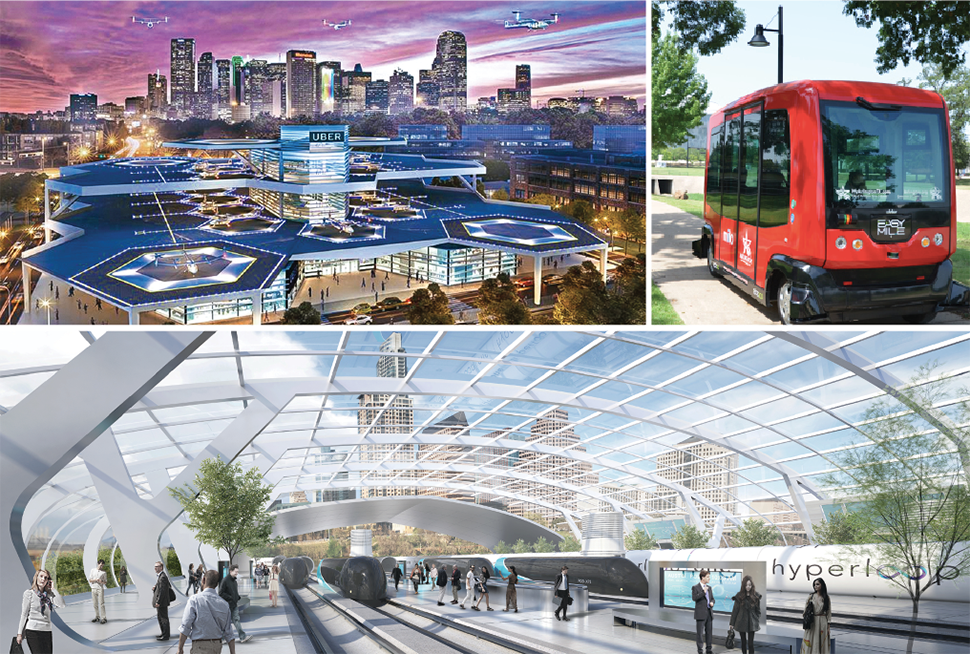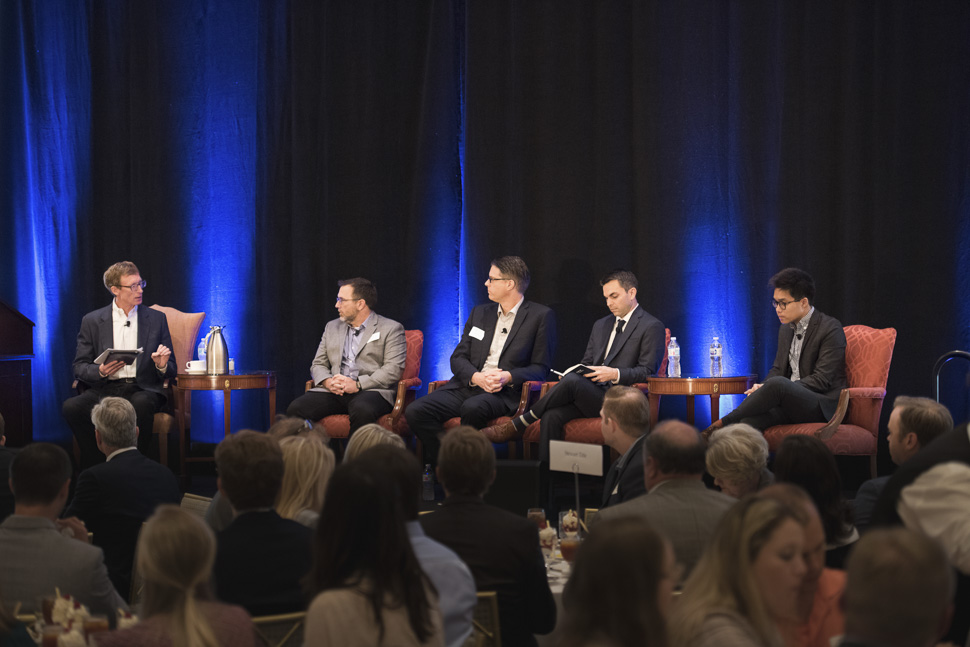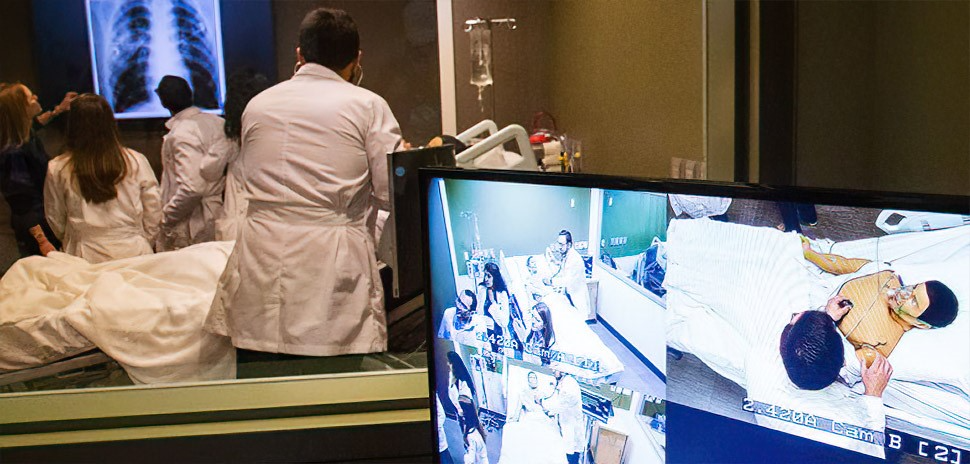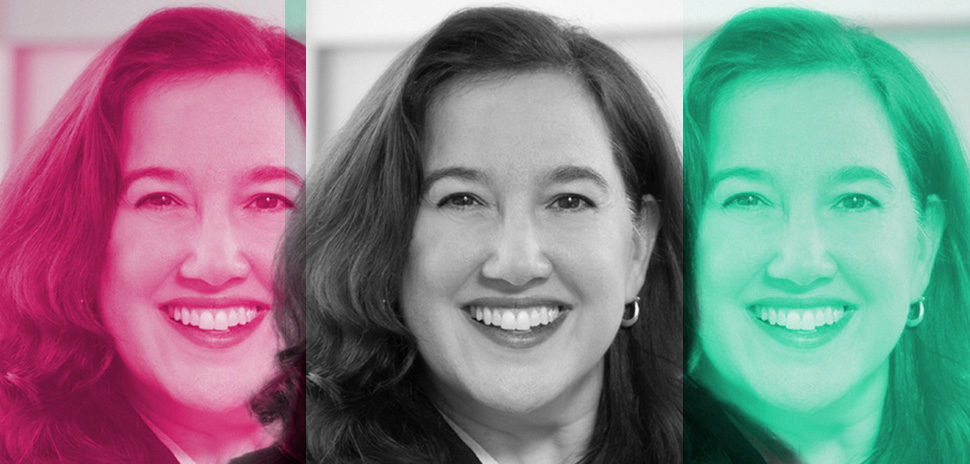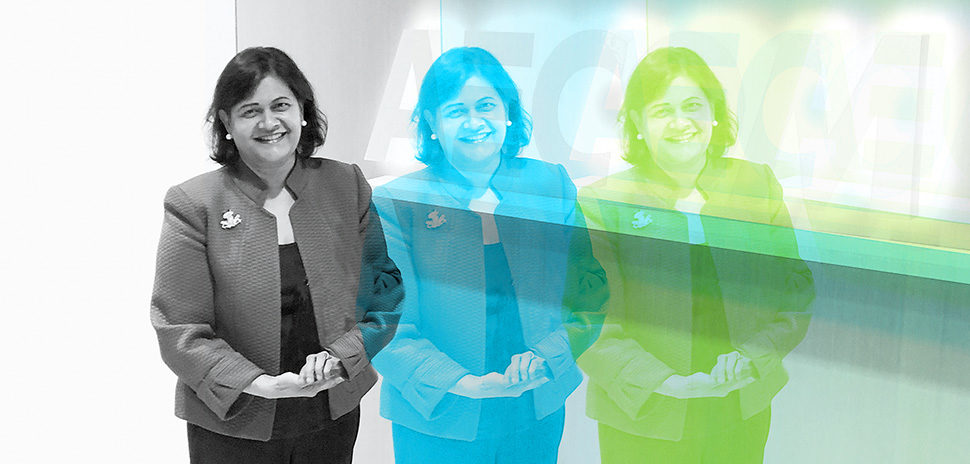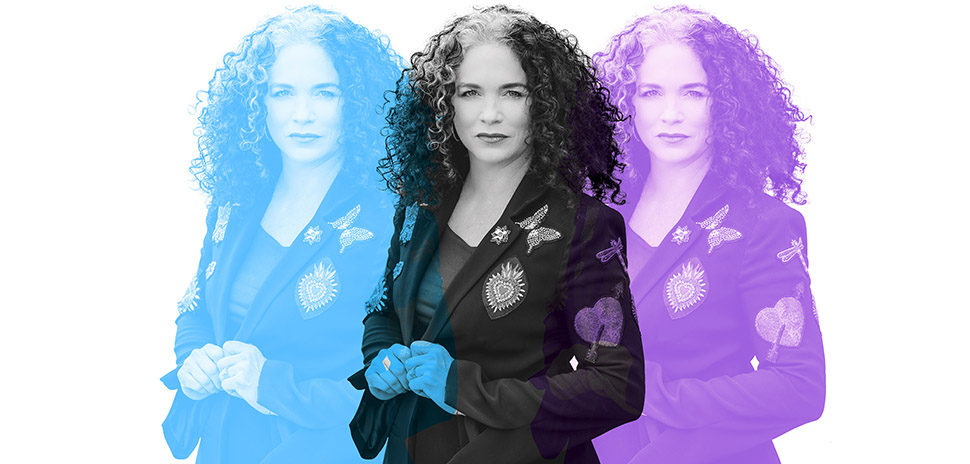Transportation is one of the most talked-about, critical elements of modern urban life. How many times have you been asked, “How was your commute today?” It’s a topic that raises many questions, such as: How do we get around more quickly and safely? How can we reduce noise and our impact on the environment?
The Real Estate Council held a panel discussion where five industry experts—led by the North Texas Council of Governments’ Thomas Bamonte—talk about what we’ll see next, from air taxis to autonomous vehicles to the Hyperloop. Bamonte and the experts dive into what we can expect in this “Transportation Revolution,” and how it will specifically impact real estate.
Meet the Experts
M O D E R A T O R
 Thomas Bamonte
Thomas Bamonte
North Central Texas Council of Governments
Bamonte is Senior Program Manager for Automated Vehicles for the North Central Texas Council of Governments, where he works on automated vehicle pilot programs and the regional data infrastructure for automated vehicles.
P A N E L
 Travis Considine
Travis Considine
Uber Elevate
Considine is Communications Manager for Uber in Texas, Oklahoma, and Arkansas. He’s primarily responsible for managing media relations and assisting Uber’s policy team at the state and local levels, as well as advancing Uber Elevate in North Texas.
 Steven Duong
Steven Duong
AECOM
Duong is Senior Urban Planner for the DFW Metro AECOM office. He works in transportation planning and urban design. He has managed a variety of projects, including the 100 Resilient Cities: Dallas plan and the North Texas Regional Joint Land Use Study.
 Michael Kaiser
Michael Kaiser
The Beck Group
As Director of Design for the Beck Group, Kaiser works collaboratively with Beck’s project teams in a variety of market sectors. “Maybe I’m best called an experience designer,” he says.
 Rod Schebesch
Rod Schebesch
Stantec
As a regional business leader in western Canada, his teams pursue and deliver transportation infrastructure projects. Focused on smarter cities, he aims to find infrastructure efficiencies that positively impact the built environment.
The panel originally appeared in the Dallas-Fort Worth Real Estate Review. The following transcript has been edited for Dallas Innovates. Photos by Michael Samples.
Michael, what is Uber Elevate? Tell us more about the transportation technology.
MICHAEL KAISER: Really, they’re air taxis—autonomous air taxis—and, eventually, they will fly you from point to point. They’re called eVTOL aircraft, which stands for vertical takeoff and landing. The Beck Group was tasked with designing a “vertiport” that would accommodate 150 takeoffs and landings per hour and that could be scaled to up to 1,000 trips per hour. It was a really interesting project. And when you’re given a project like that, you can dream and come up with some crazy architecture. Initially, you think, “This is in the future.” But then you realize, it’s actually very close. This is just five years out, according to certain projections.
The Beck Group is an architecture and construction company. We wanted to understand the process and be realistic. We also wanted to design something affordable. We based our designs on the helipads themselves—the takeoff and landing spots. We looked at those geometries and the distances that they have to be from each other to accommodate simultaneous takeoffs and landings. That probe drove the design. We looked at a hexagon and thought about beehives. That [pattern] really generated the architecture, and we diagrammed it. The design [called The Hive] is really modular.
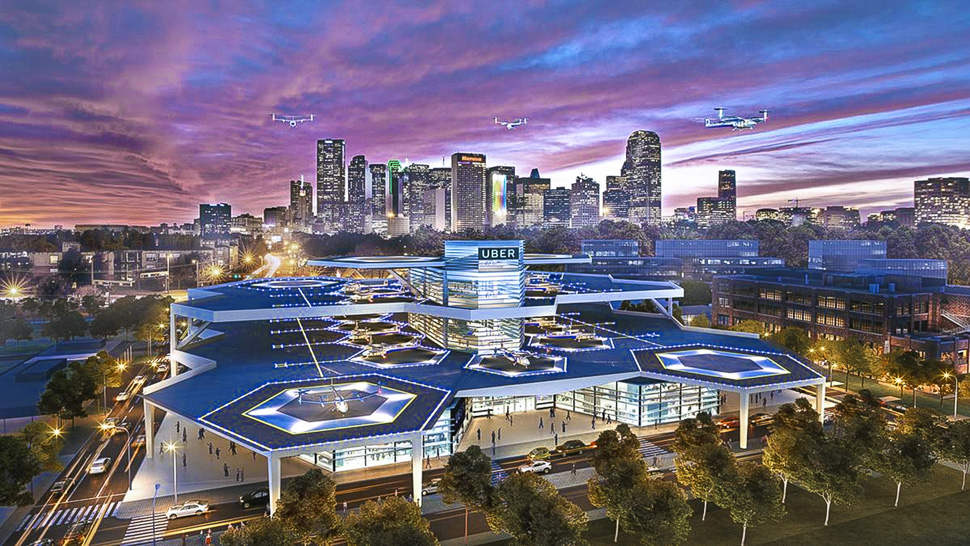
[Rendering: Uber Elevate]
Another factor was, we were given seven minutes to recharge the vehicles. That’s a quick turn-around. I think each one of them can fly 60 miles on a charge. It was a tough problem to solve for: the ability to disembark, re-embark, and recharge in seven minutes. We also looked at how to mitigate sounds. The [eVTOLs] are not as loud as a helicopter, but they do make noise. We thought about the “last mile,” too. We had to think how to accommodate that—really, it’s idea of an airport—how airport dropoffs work. Once the eVTOLs land, a vehicle could pull up and take passengers that final mile.
We provided the cost data … for the smaller one, we were looking at around $50 million for a total cost of construction. When the presentation was made about the initial study, I think $12 million was the number [brought up at the Los Angeles Summit in May] for a simple one that would be on top of a parking deck. Doing [that] construction at $50 million [for the smaller skyport version] may be a little cost prohibitive, so we’ll begin to drop those prices down to make it much more affordable.
What’s your nomination for the transportation innovation that’s going to drive the most change in commercial real estate in the next 25 years?
KAISER: Autonomous vehicles: For one thing, they’re going to reduce the requirement for parking. That’s a gamechanger because, right now, so much of what we design is around parking.
BAMONTE: Speaking from the Council of Governments, and the ambition for both the public and private sector here in Texas, Uber Elevate gives us a chance to lead in the aerial space. We’re trying also to be a leader on ground automation as other new forms of mobility emerge such as Drive.AI and the EasyMile deployment in Arlington, as well as other efforts that you may hear about soon. The commercial real estate industry is starting to consider these new forms of mobility and building that into how they design and finance operations.
“Autonomous vehicles: For one thing, they’re going to reduce the requirement for parking. That’s a gamechanger because, right now, so much of what we design is around parking.”
—MICHAEL KAISER
Rod, moving to you next. Welcome from Canada. Tell us a bit about what Stantec is doing in the transportation space.
ROD SCHEBESCH: As everyone is well aware, the future of driverless vehicles is exciting. At the same time, there are some pitfalls we have to keep an eye out for. Stantec has offices around the world. Here in Texas, we have about 750 people on staff, and we’re really excited about the market. There are a lot of growth opportunities as transportation intermingles with community development and land development. Stantec works on a wide range of projects, with all types of clients. About a year and a half ago, we completed a project in Dubai to implement CAV (connected autonomous vehicles) within the country. We also worked on the Wilmington station in Walnut Creek, California — the largest secured test bed in the U.S. The first self-driving shuttle in North America arrived there, and we tested there for about eight months before it moved on to a deployment. ACTIVE-AURORA is another test bed that we’ve been involved with since its inception about 8 years ago. We’re responsible for the infrastructure aspect of autonomous vehicles.

[Photo: Drive.ai]
We also started a project in Chamblee, Georgia—a suburb of Atlanta—at the beginning of this year. We went through a feasibility study and route selection, did some public engagement, procured a vehicle supplier, and now we’re moving to deployment. During the process, a large developer nearby heard about it. They were redeveloping an old GM assembly plant that had been demolished and became excited about the idea of connecting a shuttle to their development. Later, a community further down that line from Chamblee also expressed interest in something similar. So, there’s a trickle-down effect. I hope we see that in Frisco and Arlington as well.
“As everyone is well aware, the future of driverless vehicles is exciting. At the same time, there are some pitfalls we have to keep an eye out for.”
—ROD SCHEBESCH
There are other projects such as Tennessee DOT, where we’re doing Traffic Management Centers (TMC). Those are an important aspect of connecting people with technology—making sure you have that tied in to understand where the vehicles are and that they have the ability for communication from the vehicle to the TMC and back. We’re also doing a smart mobility plan for Nashville, again, connecting the different modes to provide a way for the area to deal with their mobility issues and get more efficiency out of existing infrastructure.
Tied into that are “urban place” projects. That’s where we blend transportation with our community development roots at Stantec. The changes in transportation present opportunities to link the way people move around to community development. … 100 Resilient Cities is another area we work in. We look at economic sustainability and the resiliency of communities. It’s a big part of our practice.
Rod, you’ve got a great perspective—an international perspective. What do you see as the biggest driver of change in the commercial real estate market from transportation?
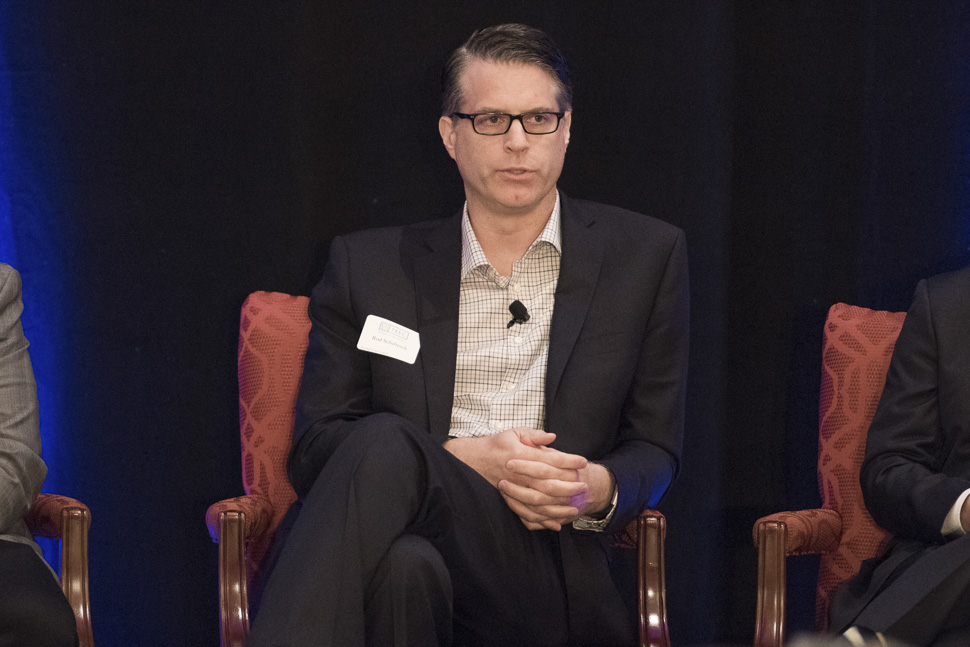
Rod Schebesch
SCHEBESCH: I’d say it’s the advent of car ownership starting to decline. While a vast majority of people can’t imagine not having a car, the reality is that it’s starting to happen. In some cities, it’s happening quite fast. If you look at your developments and think of the amount of money you spend in parking structures, I would strongly suggest that you rethink—or, at least, try to minimize—that as much as possible. … Try to minimize structured parking and use surface lots that you can later redevelop when people start paying for their ride instead of paying for their vehicle. That’s happening at both ends of the demographic spectrum—millennials and the boomers. There’s going to be a lot of money spent on parking that’s not going to be needed, longer term.
I think we all have a shared goal to make travel in the future faster than it is now. Travis, what are your thoughts on what’s going to be the driver of change in real estate over the next the next 25 years from Uber’s perspective.
TRAVIS CONSIDINE: First, a bit about the Elevate initiative and the goal of what we’re trying to do here and with all of our partners. It’s an urban, on-demand, vertical take off-and-landing, flying ridesharing network—and we chose Dallas to be the pilot city in the U.S. and North America. There are five reasons for that.
First, we have a clear opportunity here: We can serve dense populations of people spread out over several urban areas. Whether it’s taking someone from here to Frisco, or to Plano, or to Fort Worth—there’s a clear purpose. Second, our ground business in Dallas, especially, is doing quite well. That gives us valuable insights on how people move around in North Texas in general. Third, we’re fortunate to have world-class leaders as partners, chief among them Hillwood, Bell Helicopter, and several of the architecture firms designing the vertiports. Fourth, we’re working very closely with senior leadership at Dallas Fort Worth International Airport. We have an opportunity for world-class integration there and also with NASA. NASA has a facility in North Texas where we’re running simulations on air traffic where the eVTOLs will go — both to and from — to test that.
“[The Elevate] is an urban, on-demand, vertical take off-and-landing, flying ridesharing network—and we chose Dallas to be the pilot city in the U.S. and North America.”
—TRAVIS CONSIDINE
What’s your sense of what will be a big driver of change in commercial real estate?
CONSIDINE: Just as skyscrapers and elevators were able to change how real estate maximized efficiency, using 3D transportation—getting off the ground—allows cities to use space more efficiently.
Steven, tell us about your work at AECOM and on Hyperloop.
STEVEN DUONG: At AECOM, we’ve been involved in a number of initiatives over the last several decades, most recently in the areas of emerging trends and transportation mobility—as well as smart cities and the future of urbanism right here in Dallas. I’m glad you mentioned 100 Resilient Cities. Our team worked with the city of Dallas on consulting. Dallas just published “Resilient Dallas,” the first holistic resilience strategy in the city’s history [this summer]. It was a kind of blueprint for Dallas to move forward to a new future, counting for the future of mobility and environmental concerns in a socially equitable way.
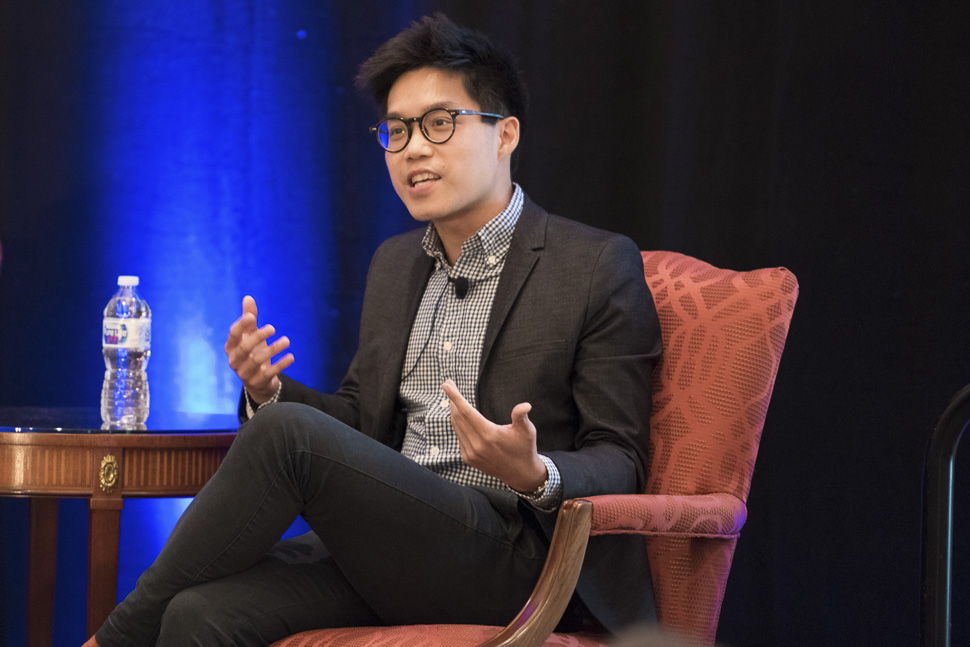
Steven Duong
Another major effort that we’ve been involved with recently is the Hyperloop of Texas initiative. Our team was part of the effort to win the Hyperloop One Global Challenge, which established Dallas-Fort Worth and Texas as one of the 10 first places in the world to focus on Hyperloop. If you’re not familiar with Hyperloop—and I always laugh when I describe it: It’s a next-generation mobility system in which you move into a pod that’s floating on magnets, inside a vacuum, zipping along to the next city at about 650 to 700 miles an hour. It still sounds great when I say that out loud. But it’s really what we’re looking at here. Theoretically, you could go from Dallas to Austin in about 19 minutes or so.
You also may have heard that another version, Hyperloop One, was in Dallas-Fort Worth recently with some presentations. AECOM is working with several different firms on a concept that we call “hypermobility.” There are a lot of different technologies that will stretch our cities in interesting ways.
What I think will be the most impactful technology on real estate is—and I’m not going to say the answer is Hyperloop—the concept of mobility as it’s surfacing. That doesn’t mean that people won’t own a car, although I do think most in the industry expect that to happen in the near future. Instead, it’s the idea of treating mobility as a commodity—something you can own, manage, and control—it’s a service, just like Netflix is a service to all of us. It’s something you may subscribe to, and it operates in the background of your life. You can get access to mobility anywhere you’re sitting. You don’t have to worry about how to get someplace. You don’t have to worry about how much it costs: You just go.
That impacts real estate. You can think about mobility as a service and as a trend. While you’re using an autonomous vehicle or a flying taxi or Hyperloop, you can do whatever you want in that vehicle because you don’t have to drive it. Transportation can recede into the back of your life. So what happens on the end points of your trip—the beginning and the end—mean even more. When you boot up your phone, you have to tell it where to go. You won’t necessarily have that serendipitous experience of exploring.
“What I think will be the most impactful technology on real estate is—and I’m not going to say the answer is Hyperloop—the concept of mobility as it’s surfacing. That doesn’t mean that people won’t own a car, although I do think most in the industry expect that to happen in the near future. Instead, it’s the idea of treating mobility as a commodity—something you can own, manage, and control—it’s a service, just like Netflix is a service to all of us.”
—STEVEN DUONG
People have to know your development or business exists — and they have to want to go there. For them it’s not about a trip anymore, it’s about where they want to go. And that means placemaking and branding matters even more.
Transportation is something that will happen in the background to get people from point A to point B. That’s a philosophical change in how we think about transportation and how we expect transportation to service us as citizens of a city. That’s going to take radical rethinking. That applies to every sector of urbanism, in general: placemaking, urban design, real estate, workforce development, economic development — everything. It’s the philosophical change itself that is a radical shift.
Let me pick up on that. Pun intended, Uber is developing a vertical with Uber Elevates—literally—but also through shared vehicles and personal vehicles to things like bikes and electric scooters. What is the prospect for a shift to shared mobility versus vehicle ownership? What are the obstacles and challenges that Uber sees in making that transition?
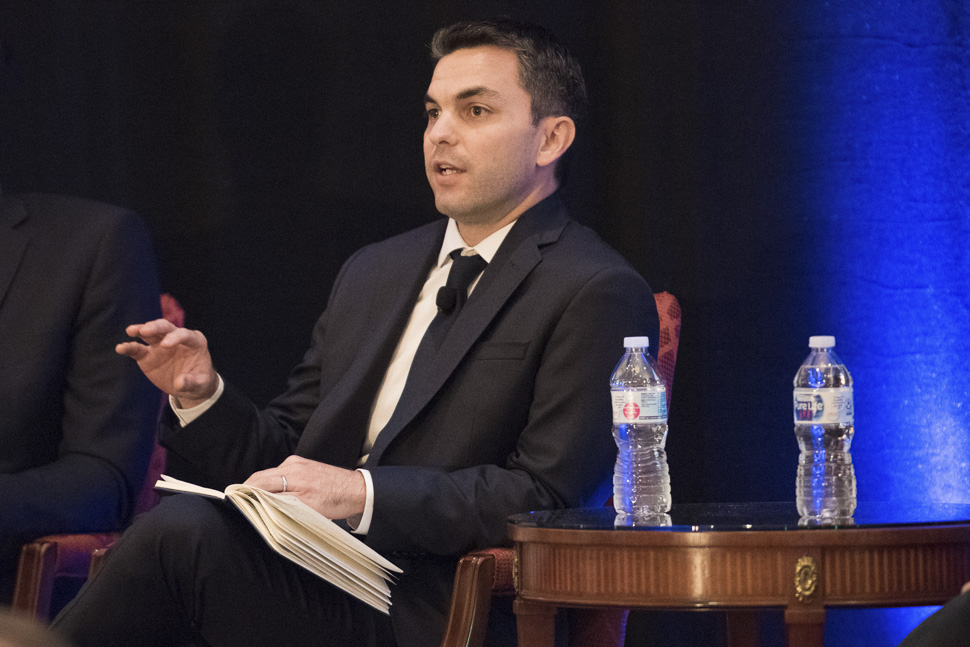
Travis Considine
CONSIDINE: Our new CEO, Dara Khosrowshahi, has a clear vision to make Uber a multimodal platform from top to bottom. That means you can pull out your phone, and with the push of a button, you can get on a bike, on a scooter, in a car, or eventually, in an eVTOL.
Let’s say you’re leaving work downtown, and it’s rush hour. Maybe you don’t want to hop in a car because you’ll just sit in traffic. So you grab a bike and ride it somewhere where it’s less densely populated. Then you can grab a car —or ride it to a vertiport. If, for example, you’re trying to get home to Plano, you could—still in the app—drop the bike off, get in an elevator, go to the top of the vertiport, and get in your eVTOL. That would take you to the Frisco station, and from there you could catch a ride in an Uber to get home. In the past, Uber has helped a lot of transit agencies do the first and last mile of a trip … with this being fully multimodal, we can truly help get you from A to B.
Let’s throw this to the panel. There’s some skepticism about the likelihood that a prototypical soccer dad—one with two kids in tow and a couple of bags full of equipment—would be willing to embrace that utopian vision. What’s the likelihood that North Texans—and folks in general—will move away from private ownership of transportation? After all, our ancestors had their own horse and buggy, and now that’s shifted to a private automobile. Why do we think that now is the time we’re going to see a shift to transportation as a service?
SCHEBESCH: That’s a good point. By no means are we expecting everyone to put their car up for sale and move on. But, in reality, we’re talking about a transition period in the way we live our lives and how we get around in terms of mobility as a service. That’s moving forward in some parts of the world—very early stages are showing progress—but it’s going to take some time. It’s going to be a gradual transition. People are going to resist that change: They love their vehicles, and they have no intention of giving them up. But the implementation of connected vehicles—tying them to traffic management centers, and starting to develop the idea of a potential CAV (Connected Autonomous Vehicles) lane instead of a hot lane or a managed lane—is something that’s definitely in discussions. It’s a feasible option. It would allow those vehicles with the technology to be able to move forward. Toyota recently announced that all their vehicles are going to have connected vehicle onboard units as a standard feature across all models. There’s also a big move toward CAV technology in China. Really, the pace of that development is madness. The reality is that the technology is moving forward. The key is looking at how that’s implemented through this transition period.
DUONG: My personal opinion about technology being adopted tends to be more optimistic. As generational changes happen, technology adoption also happens. Let’s talk about smart phones, for example. Spoiler alert, it was 2007 when the original iPhone was released. One decade later, I guarantee that almost every single person in this room has a smart phone in their pocket, and they get nervous when they accidently leave it behind. Technology is being adopted faster than ever. 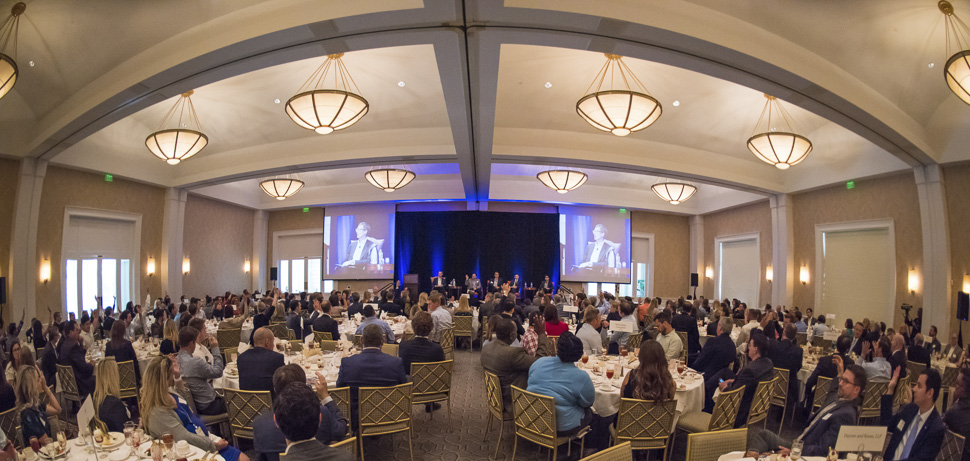
With Uber, there’s a satisfaction of having someone—or something—else take you somewhere. You don’t have to worry about it. In our office at AECOM, it’s not necessarily our opinion that people love their cars: It’s the freedom they love. Texans in particular. And in Texas—with the way we design our cities—the car represents that.
What happens if freedom can be given to a population through something other than a vehicle? What you might see is rapid adoption of something like an Uber or Lyft or any other kind of mobility as a service option. It’s not that far in the future, and I do think it’s going to happen sooner than later.
In Helsinki, Finland—they launched a service called Whim last year. I think it was advertised as the first larger-scale mobility service model in the world. For the equivalent of [about] 600 U.S. dollars you get unlimited rideshare, unlimited car rental, unlimited transit, unlimited bike share—unlimited literally anything that can get you around the entire region of Helsinki. So you never have to worry about insurance, about maintenance, anything. You pay the fee, and you get unlimited access across the region. It’s doing really, really well. I think that [idea] will most certainly catch fire here in the U.S. We’ve seen technology adopted extremely quickly from 2008, forward. We should expect that same level of optimism here.
“In our office at AECOM, it’s not necessarily our opinion that people love their cars: It’s the freedom they love. Texans in particular. And in Texas—with the way we design our cities—the car represents that. What happens if freedom can be given to a population through something other than a vehicle?”
—STEVEN DUONG
KAISER: I have three daughters—two of them are grown and driving now. They didn’t want a car [initially]. While I can’t imagine giving up my car, I do think it’s a generational thing. So maybe not everyone gives up their car, but if a family goes down to one car that’s still a tremendous reduction. As we look at how that impacts real estate, we’re trying to determine what that overall reduction will mean for the parking facilities.
BAMONTE: Let’s do some public opinion polling here. Raise your hand if you would give up one of your vehicles if, for $5,000, you could have unlimited access to Uber, Lyft, scooters, everything else—basically offering mobility as a service? (Ed. note: There was a good showing of hands raised.) I think we’ve sparked a transportation revolution here.
Rod, you’ve talked about connected vehicles. Do you think that through electronic connections between vehicles, pooled rides where we share vehicles, and other techniques that we can squeeze more vehicles on existing roadways? Are we at peak roads?
SCHEBESCH: I think we’re definitely approaching that. But there are development trends that have been going on for decades, and that’s not going to stop overnight. But I do agree that technology and mobility options will accelerate once they become more popular. I think the insurance companies will help to generate that.
We haven’t talked about safety, but with the idea of going to a self-driving vehicle versus one that’s human driven, there’s a benefit you get from a safety perspective. … So I think there’s going to be a rapid adoption. Also, at the same time, there’s will still be some development. Not everyone is going to become an urbanist.
I completely agree that this is [something of] a generational thing, and that it’s evolving. …I don’t know if politicians and governments have fully wrapped their heads around it yet, but the ability to free up [money] that’s spent in infrastructure and look at investing in sustainable infrastructure and technology is going to be a good opportunity, looking to the future.
Steven, you were involved in the resiliency project for Dallas. Does greater reliance on automation in transportation advance resiliency, or does it expose us to a whole host of additional risks when you take humans out of the equation?
DUONG: I’ll answer that a couple of different ways. If you’re looking at connecting vehicles in a silo, I think we’re going to see a major spike in roadways. I don’t think we’re anywhere near peak roads. I say that for a couple of reasons which will help answer the resiliency question.
First, people haven’t really considered that having autonomous vehicles means a greater segment of the population will be making trips. You won’t need a driver’s license anymore. Anyone of an age we think is reasonable can make a trip. The actual percentage of the population who will be making trips more frequently will expand. Second, throughout history, whenever we’ve made driving easier, we’ve built more roads and done more development. I don’t think that’s going to change.
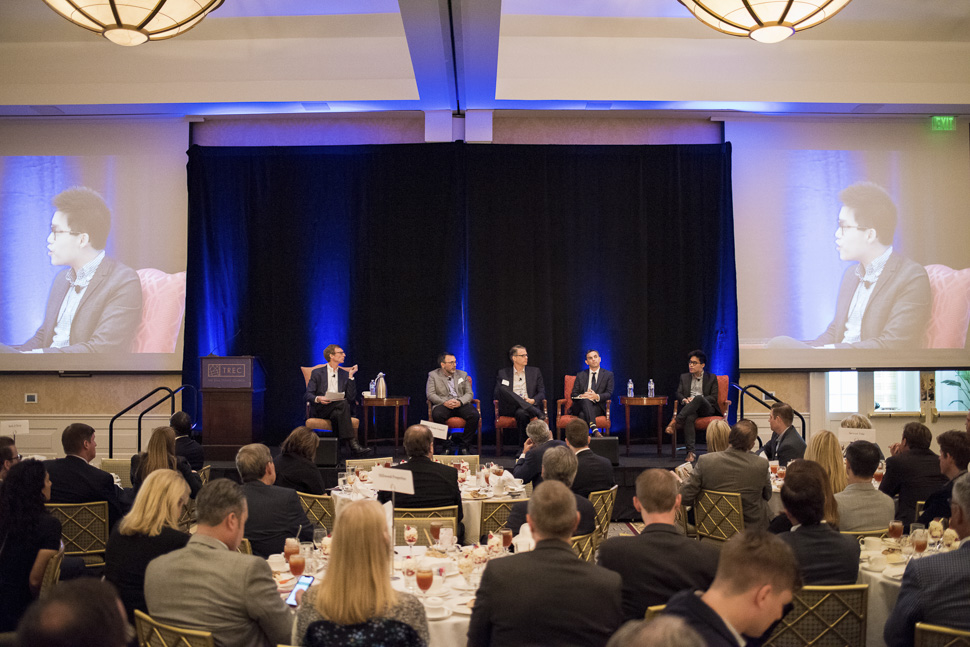
Let’s say our general comfort level for a commute is 45 minutes—and a lot of that is the pain of driving a long while. But if the drive to work was as comfortable to you as sitting in your PJs at home, you might drive a lot further. That means people are going to live further out, and that means more roads.
Working with the City of Dallas on the Resilient strategy, we took a systems design approach. We looked at the major factors that are fluid in the cities, understanding that transportation is, in some ways, the building block of the modern city size. We used to design cities based on a human scale, the streetcar scale, then the automobile scale. What happens when we get to the CAV (connected automated vehicle) scale?
There’s an argument that more sprawling, far from developments, can be negative on us as a society—especially in terms of resilience and adaptation. That means letting these technologies go forth without really thinking critically about how to curb the effects could actually lead us down a less resilient, less sustainable path. Both the public and private sectors would be considerate of that. While we know these technologies have the ability to unlock potential and do great good, they also have the potential to do the opposite.
What Steve is saying is something that keeps planners up at night. They have new transportation technologies, and they increase the centrifugal effects of development. So how might the private and the public sectors respond to make sure our cities flourish as opposed to continuing to sprawl out?
SCHEBESCH: I agree that trips are going to increase, but I think also the efficiency of the road traffic is going to increase. So the idea of getting more trips and more vehicles through platooning and connected vehicle corridors will help to complement a lot of the growth and those trips taken. And I think the electrification of vehicle speeds is definitely moving forward and will become the norm in the future. From a sustainability perspective that will help.
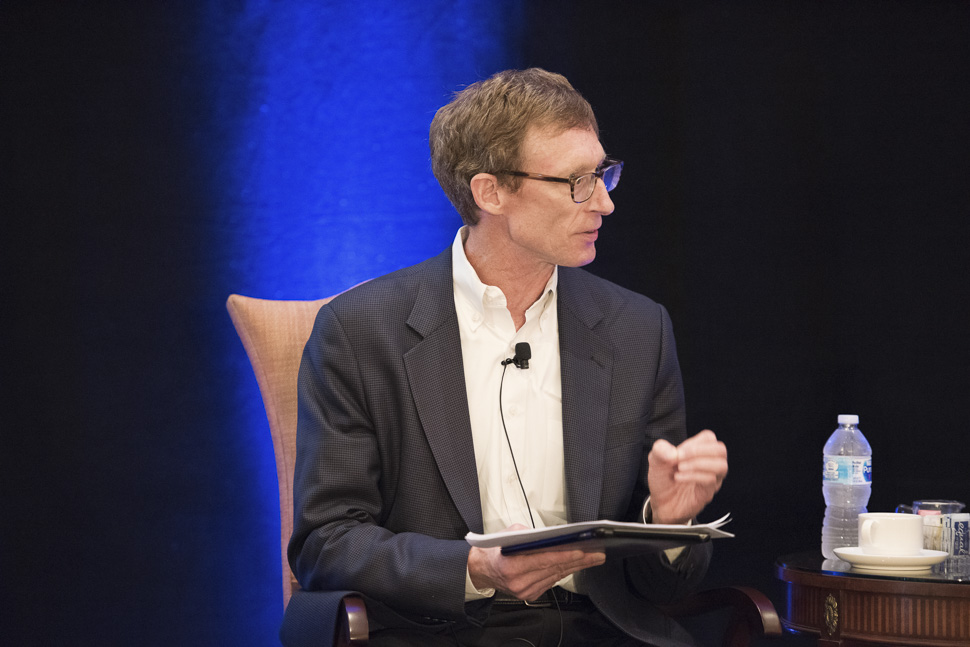
Thomas Bamonte
The key thing with that is electricity itself isn’t necessarily clean unless it’s generated from a clean source. So if you are burning coal or fossil fuels to generate the electricity you’re not helping much—in fact, you would probably be hurting the environment more.
BAMONTE: Let’s do another crowd-source opinion polling to test Steven’s point. If you could—safely in your vehicle—watch crazy cat videos to your heart’s content on your commute, how would that extend your tolerance for commuting? Would you have a longer commute if you could have another screen, and you wouldn’t have to do the driving task? Raise your hand.
Okay … We’re seeing sort of a mixed result. Maybe there’s just an inherant half hour, right?
“The key thing with that is electricity itself isn’t necessarily clean unless it’s generated from a clean source. So if you are burning coal or fossil fuels to generate the electricity you’re not helping much—in fact, you would probably be hurting the environment more.“
—ROD SCHEBESCH
KAISER: That eventually could benefit smaller cities and towns in Texas that people have moved away from. But I think people are always going to want gathering places and public spaces. That could reenergize our smaller cities because now more people might move there because the commute from there is not that bad. So it could have a very positive effect.
The other thing is the heat item effect of just how many parking lots we have and how much parking we have in general. For example, look downtown at the parking garages and parking lots. Once we get rid of those and convert them to either sustainable buildings or to park space that should have a positive effect on the cities.
I think we owe the audience some sense of timing. It’s a hard question because we’re talking about multiple technologies from the Hyperloop to automated vehicles on the ground to aerial vehicles. When are these technologies coming? When are they going to be mature and have an actual “real life” impact on the commercial real estate market?
CONSIDINE: For Uber Air, we want to start testing in DFW by 2020 with full commercial operation by 2023.
BAMONTE: Uber is also active in the ground automated vehicle space. Any thoughts on timing there?
CONSIDINE: After the incident in Arizona we hit pause and have been reevaluating, but we plan to move forward. Timing-wise, I’m not quite sure.
BAMONTE: You also recently announced a major partnership with Toyota.
CONSIDINE: Absolutely, another strong partnership here in North Texas.
“For Uber Air, we want to start testing in DFW by 2020 with full commercial operation by 2023.”
—TRAVIS CONSIDINE
Steven, the techno optimist, what do you say?
DUONG: I will say it two ways. In terms of a hardware perspective, I think the tech firms seem to be moving quickly. A version of Hyperloop One intends to have a working Hyperloop somewhere in the world by 2022. That may or may not be the U.S., but it’s something that they expect to have in the ’30s or ’40s. This is something we expect in the next half decade to a decade. It’s moving quickly, but there’s a lot of innovation coming to transportation that’s not built on moving dirt and building things. Building hardware is a lot of it, as is software and policy. It has the ability to move incredibly fast.
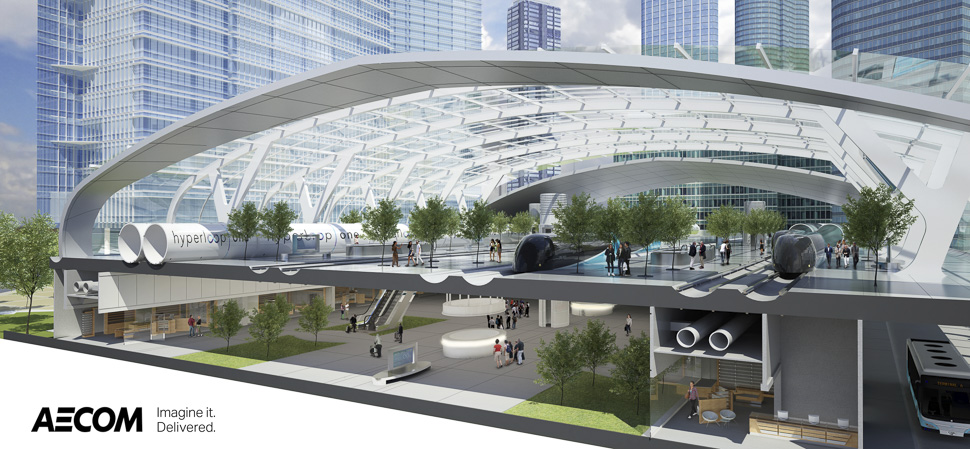
[Photo: AECOM]
If you look at what’s happened over the last five to 10 years in transportation, it seems the seas have somewhat parted in a lot of ways on both the federal and local level in terms of regulation on allowing this technology to take a step forward.
I think that’s reflective of the pent up frustration that people have with just driving around. Everyone can relate to it. When new innovations come out, such as the Hyperloop, people tend to be more optimistic about it because they see it as, “Maybe this can make my drive much less miserable.” It seems to be a consensus that people know it’s an issue. We all want to address everyone’s benefit. So it’s time to make the policy happen, and that seems to be happening.
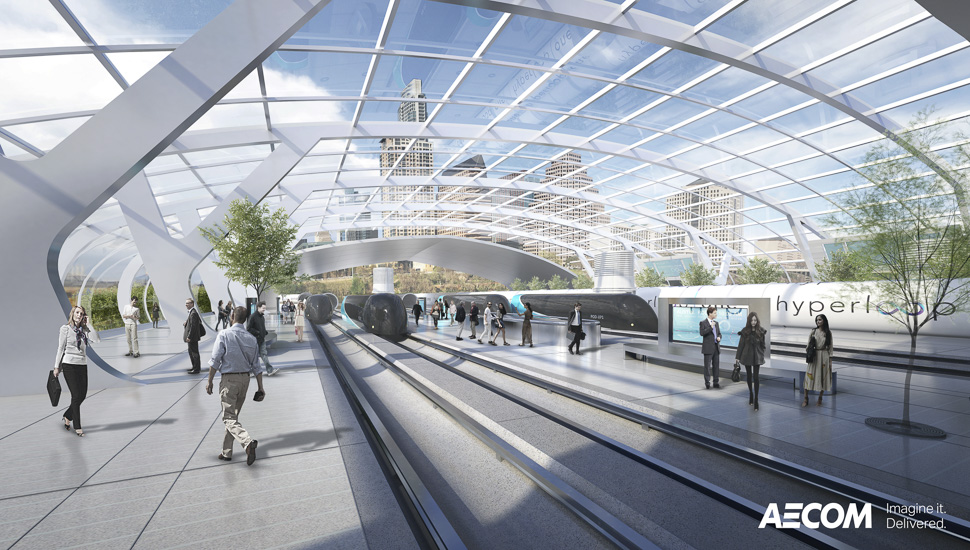
[Photo: AECOM]
KAISER: Think about the growth in Dallas-Fort Worth. The numbers that I have seen are staggering: We’re going to double in population size in the region by 2030. … We’re going to need multiple modes of transportation to make it work.
DUONG: Tom, you and I have talked about this: Making huge investments into our transportation infrastructure. The long-term forecasts are, quite frankly, still pretty terrible. We’re still seeing parking lots. And we’re spending billions and billions and billions of our tax dollars to sit on a parking lot on highways. We need a lot of open-mindedness to look at different solutions. Clearly what we are doing now isn’t working.
“Think about the growth in Dallas-Fort Worth. The numbers that I have seen are staggering: We’re going to double in population size in the region by 2030. … We’re going to need multiple modes of transportation to make it work.”
—MICHAEL KAISER
Let me take a quick detour. Rod, your region includes Western Canada. Vancouver is pursuing a development path of no expressways in the inner city and has a heavy emphasis on public transit and bike/pedestrian environments. It’s generated some of the highest real estate values in the world. Is that a model Dallas-Fort Worth should emulate, or is there something about our development patterns that lend us strength and the ability to compete globally?
SCHEBESCH: I think the Vancouver scenario is a little bit unique. One of the things that’s driving a lot of that is the cost of real estate. And one of the attractions of Dallas is that fact that the cost of living is relatively low. So that’s a draw.
In Vancouver to buy a tear-down, thousand-square-foot bungalow was 2 million dollars. What that’s doing is preventing young people from moving there—from being able to live and own real estate. So it’s changing development patterns. I think it’s sustainable, but it’s very expensive. So to replicate something like that and market it here—I think that’s a challenge. Having said that, there’s a demand for it. As we mentioned, for the millennials and the baby boomers, the future of much of the growth moving forward is around transit-oriented development, and you’ve got a great team at work here.
When are folks in Dallas-Fort Worth going to feel the impact of transportation innovation?
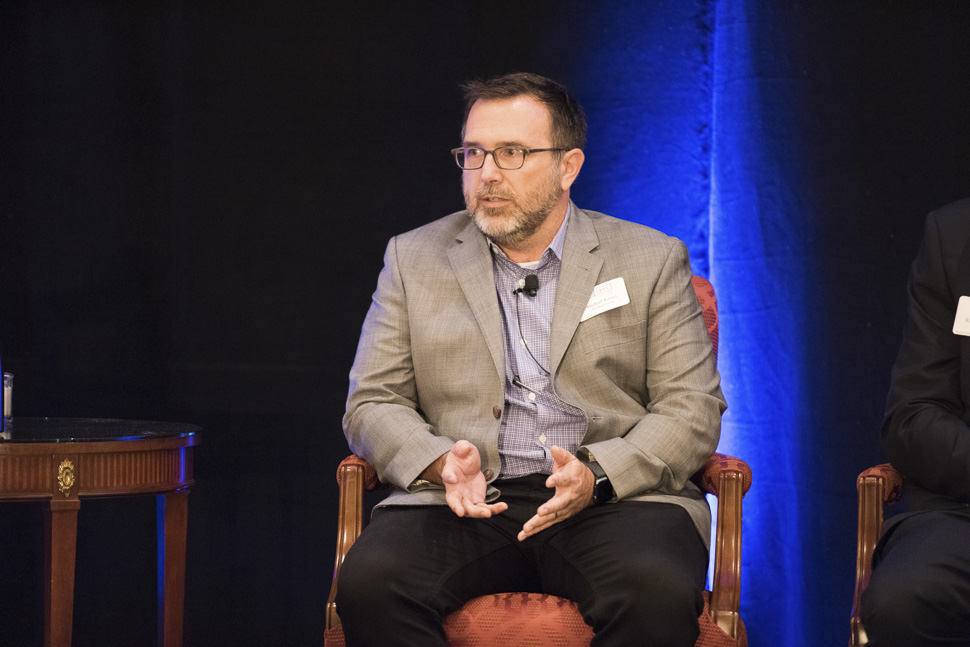
Michael Kaiser
SCHEBESCH: If you think about the amount of infrastructure that’s been built over the last 50 years, it’s been a tremendous investment. As far as fully-autonomous vehicles, those are still a little ways away … it’s very, very challenging. They’ll figure it out over time.
Michael, you have the final word in terms of your assessment of timing with this transportation revolution we’ve been talking about.
KAISER: It needs to happen. … I think it’s going to happen quickly.
The Real Estate Council’s Transportation Revolution panel discussion was held in September 2018 at the Belo Mansion. The transcript has been edited for brevity and clarity by the editors of the Dallas-Fort Worth Real Estate Review.
Read the digital edition of Dallas Innovates’ sister publication, the Real Estate Review, on Issuu.
The Dallas-Fort Worth Real Estate Review is published quarterly.
Sign up for the digital alert here.
![]()
Get on the list.
Dallas Innovates, every day.
Sign up to keep your eye on what’s new and next in Dallas-Fort Worth, every day.

